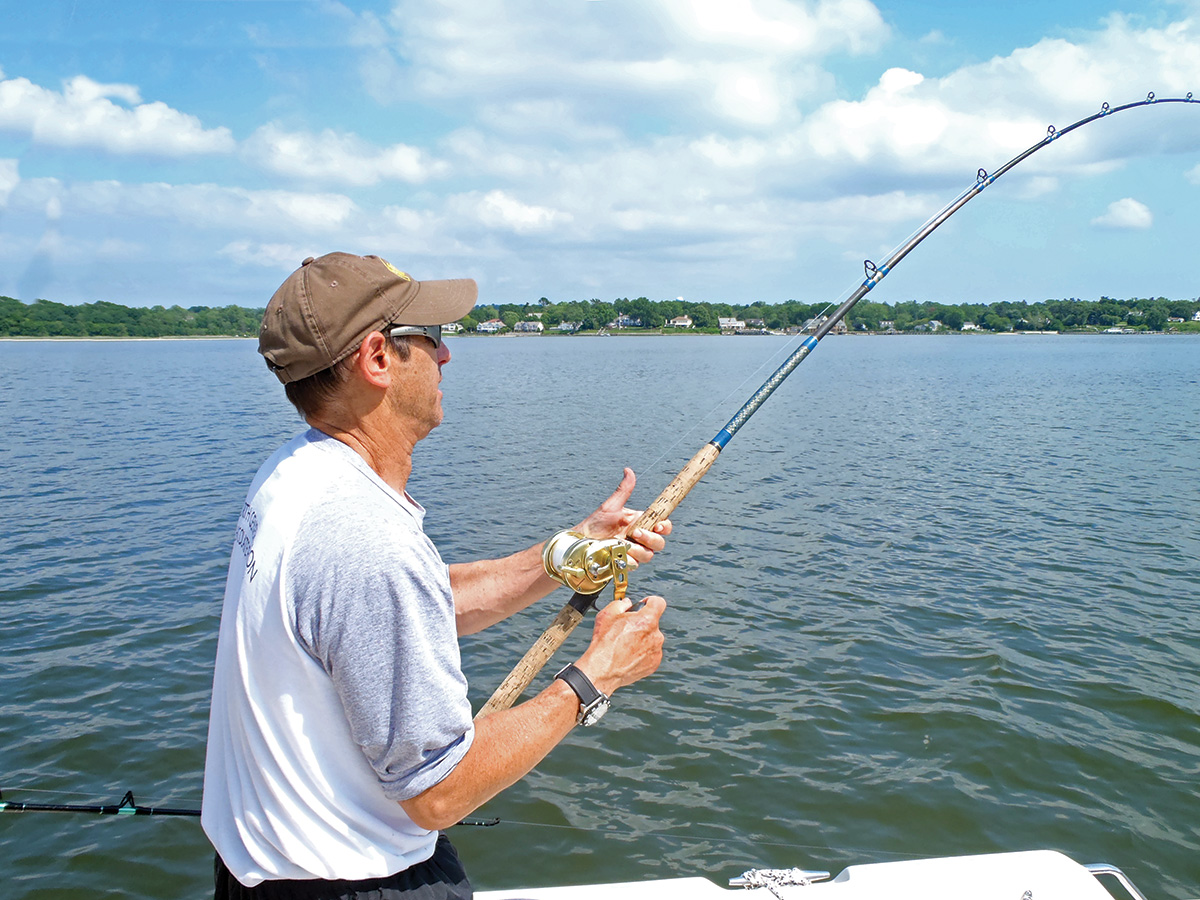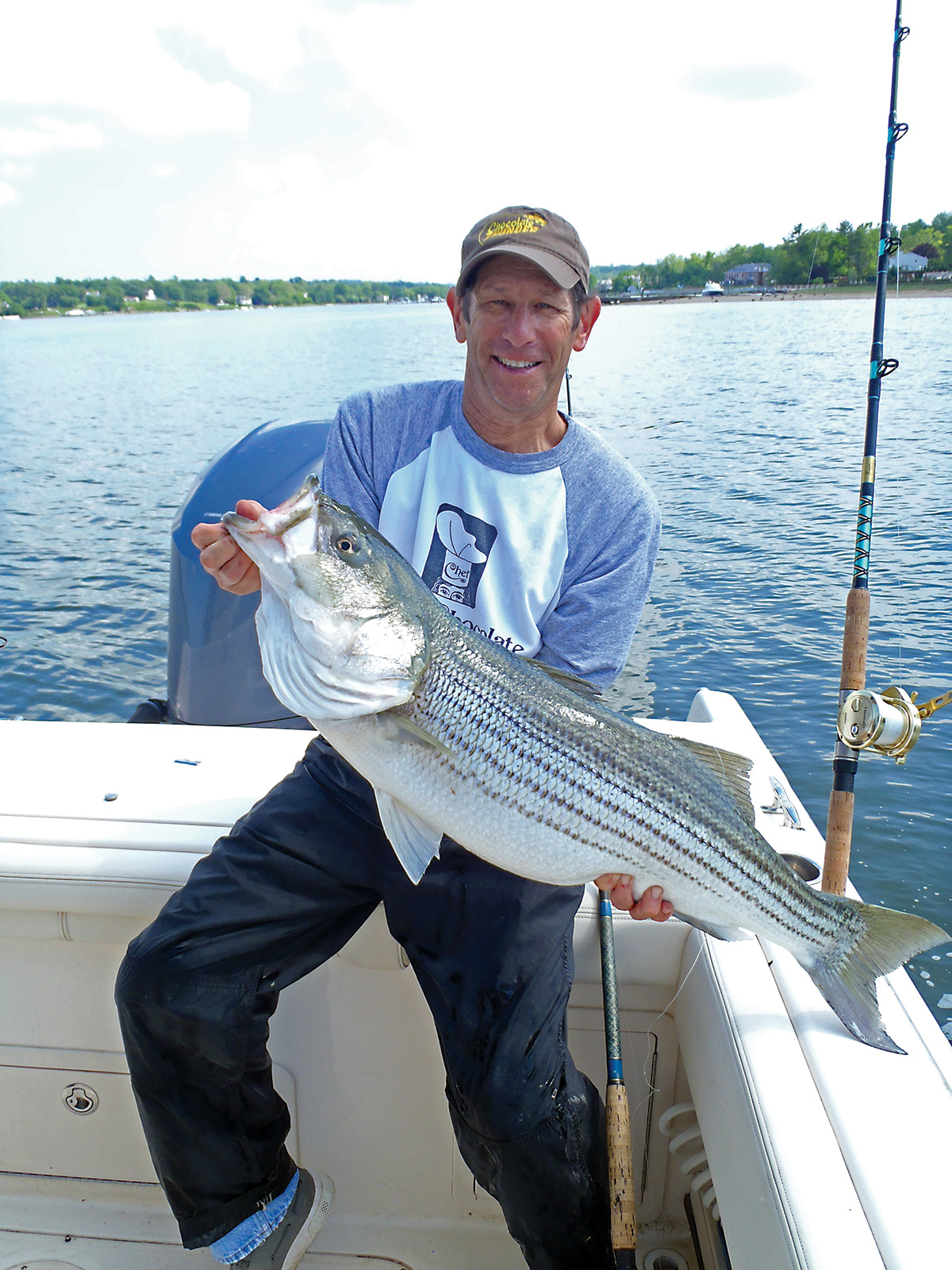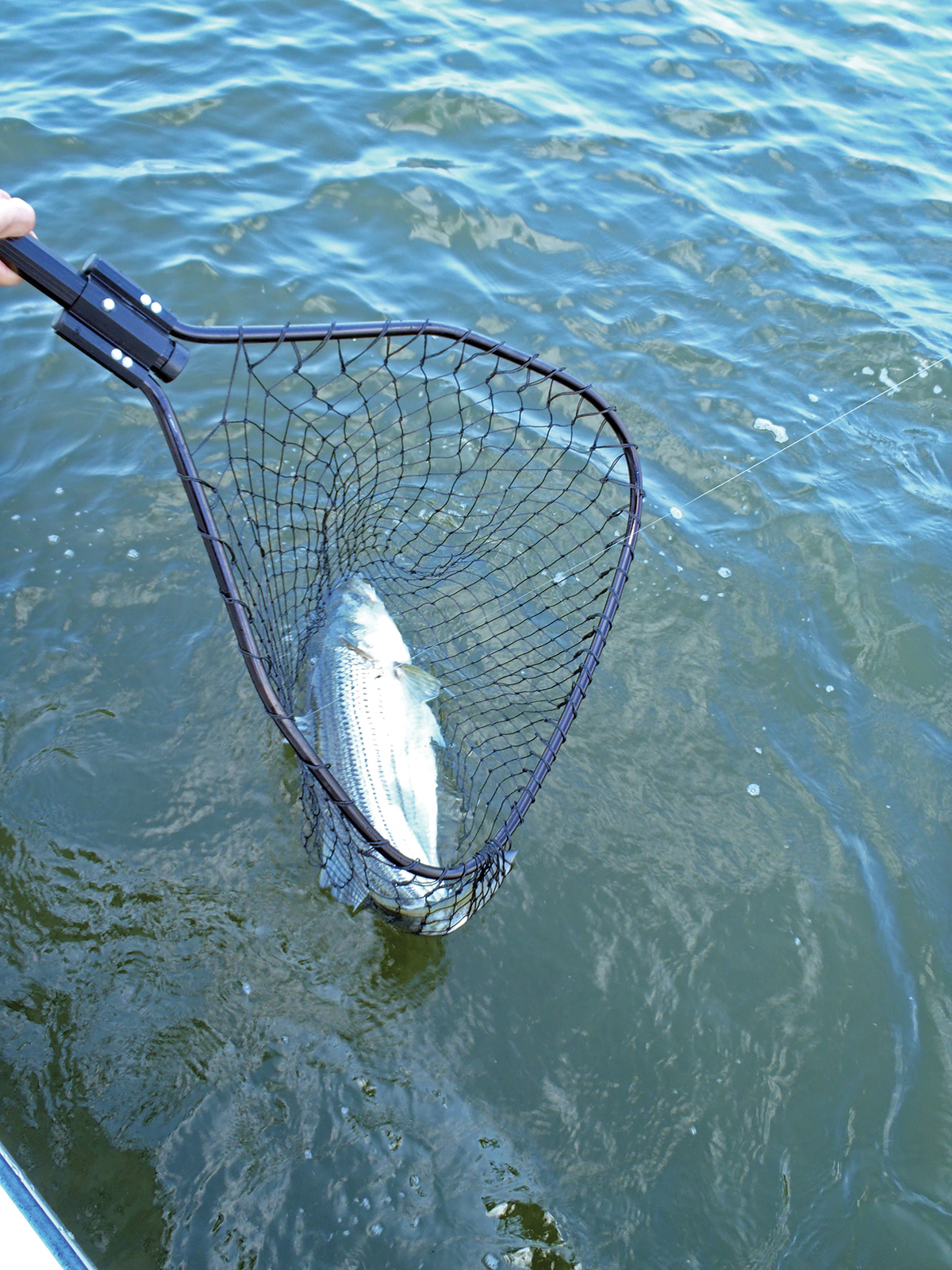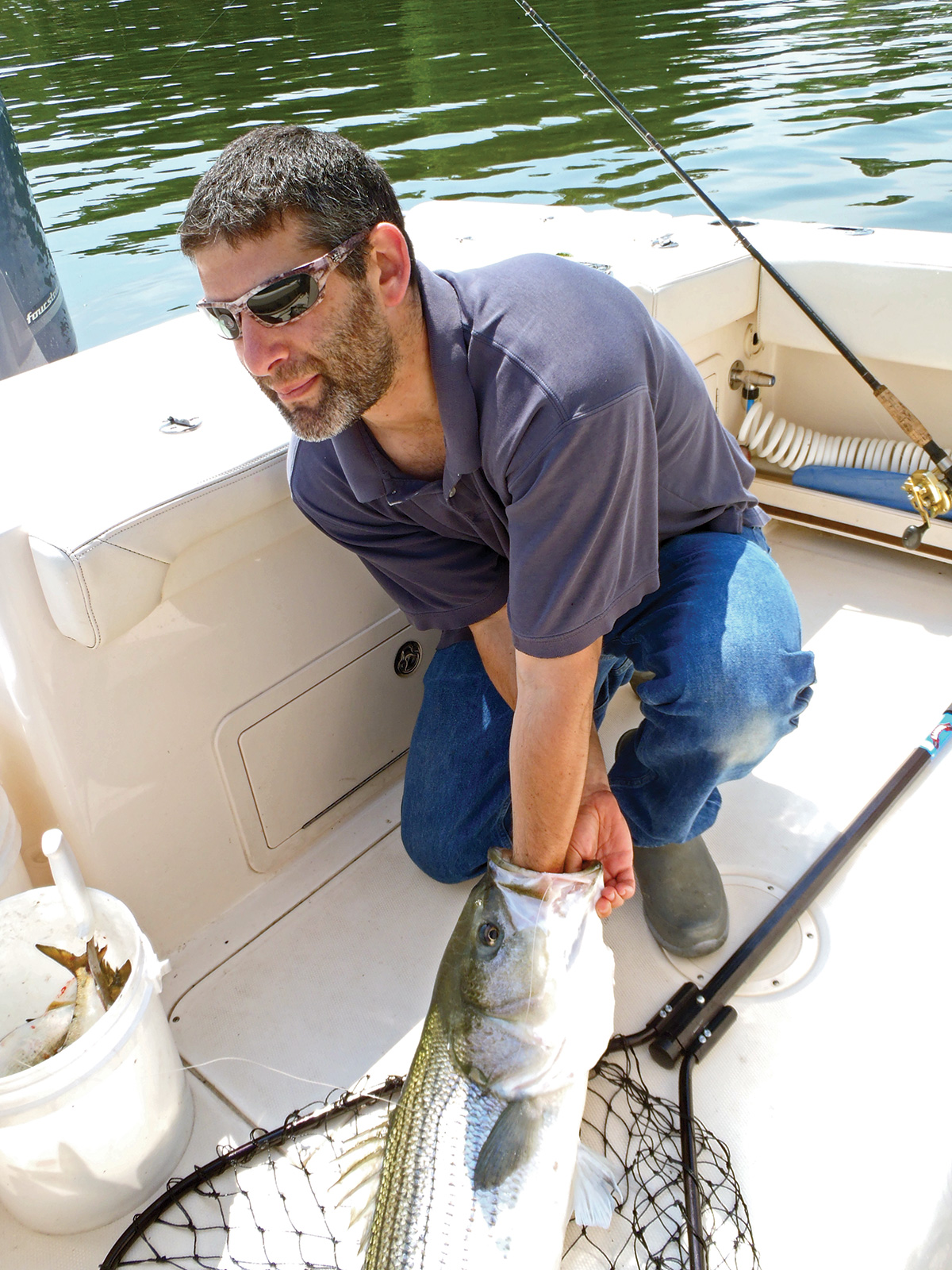
My heart races when I see a big striper stalk, taunt and attack a live bunker at the surface. I suppose I get a thrill out of intruding on Nature’s predation window that is otherwise cloaked by a layer of seawater. It’s a dramatic process and a glimpse into the life and death existence of fish that is a part of everyday life for them. Of course, if there’s a hook in that bunker, there’s added excitement in anticipating that the striper will eventually grab it, and perhaps the angler will hook, fight and land it.
Every time I go live lining with the Lazars in the western Sound, I’m impressed with how different striper temperaments can be from one day to the next. I guess the same is true of most fish species, and I admit that I’ve noted changing striper moods while fishing with lures, too. But, their moods become a lot more obvious when live lining, because the technique allows us to glimpse and evaluate it at the surface. Even when conditions remain virtually the same; tide, wind, season, and lively bunker as bait, one day they are aggressive and the next day laid-back. Yesterday the stripers came out of nowhere, attacked, left a big hole in the water, and swallowed the bait fast. They were aggressive and even violent as they fed, but the next day the mood changed and they became almost timid. At such times they are less aggressive, stalk the bunker from below, and appear to lack interest save a teeny bit of curiosity.

Bunker Behavior
The Lazars have taught me to evaluate striper moods by analyzing the behavior of the bait. Bunker may not be intellectuals, but like all successful wild animals, their survival instincts have evolved to a high level. The end result is that bunker seem to sense when bass are lethal and when they are casual. That doesn’t mean we can’t catch them when their mood is funky, but success will require more skill than when the stripers are “hot.”
I’ve been taught to watch the bunker carefully. Stripers are on a serious hunt when the bait begins to swim fast, back and forth, within a limited zone. The faster they swim and turn, the hotter the predator below. On the other hand, less dedicated hunters alert the bunker differently. In this case, the bunker may swim just a little faster than usual, but their turns are wide and casual, rather than panicky and tight. On days of modest interest, the striper below suddenly seems to give up, and the bunker resumes its normal slow throbbing pace. Typically, the striper is still in the neighborhood and in some amount of time, the bait picks up speed, and then calms down again. When a striper is in this kind of funk, it may give up the hunt completely or revisit the same bunker over and over without attacking.
A nervous bunker is the cue for the angler to pick up the rod and stand by anxiously, waiting for the finale when the bunker disappears into a swirling hole in the water. But when stripers are in a funk, the decisive stroke is never made, and all is quiet again. Not only may a noncommittal striper harass the bunker over and over without touching it, but also sometimes mouth a bait and take it under, only to release it in seconds. In this situation, if the angler sets the hook with the bait cross-ways in the bass’s mouth, the hook pulls through the bunker, and the fish never feels steel.
All of this cat and mouse nonsense begs the questions, “can we catch stripers when they’re in a funk?” “How can we entice this curious but noncommittal striper into striking?” Begin by accepting frustration, muster some patience, and try not to question the technique. On days when stripers are aggressive, live-lining is breathtaking, hours pass like minutes, and many fish are landed. On “funky” days, the angler may become frustrated quickly and begin questioning the methodology. Are the bunker too lively, or not lively enough, am I letting the fish run too far or not far enough, and should I be more pro-active with the rod in my hand to entice the bass to strike?

Magic Time
Clearly, on funky days casual live-liners like me are often stymied. These are the times when only experienced live-liners catch fish. These are also the times when I hand the rod to Rich or Marc so they can work the magic that I don’t even understand. In all fairness, I only get to do this type of fishing once or twice a year, so handing over the rod doesn’t bruise my ego.
I guess Rich and Marc sometimes experience me as a pain in the you-know-what because I constantly ask questions during the cat-and-mouse moments. “How do you know there’s a bass under that bunker? Why won’t the striper take it? Is there anything I can do here? You get the idea. I simply don’t grasp the subtleties; the magic, but that doesn’t mean I don’t want to know. As an angler, I’m used to understanding what’s happening when I’m in my element, such as surf fishing, but here it’s another story. Yet, since I hate not knowing, I study the Lazars who are accomplished live-liners. To be fair and honest, they don’t have time to go into deep explanations while a striper is stalking a bunker. There’s too much happening too fast. So, I watch, and try only to ask questions during the calm moments. Still, a person can learn a lot by watching, but being able to remember on the next trip well, that’s something else.
When I began the process of becoming a very serious surf angler, I was fortunate to hook up with several sharpies in the club I joined. This was an “old school” time in the 20th century when experienced surf anglers didn’t share much. However, they let me fish with them and they never objected to me watching them. At first it was all foreign to me, but in time I began to see the little things that made them so successful.
So, I watch the Lazars, and I listen, too. When a striper arrives under the bait, the first thing they do is evaluate how “hot” the fish might be. They do this by studying the bunker’s behavior and exchanging opinions. Is the bait excited but not frantic? How fast is it swimming away from the beast below? They also signal each other silently and offer crisp short phrases that they understand without explanation because they’ve been doing this together for decades. They usually have four live baits out at one time, and that means they have to tend the hooked baits by moving rods from one holder to another, picking up slack or letting line out, and sometimes pulling sharply on the bunker so that it splashes a bit before it resumes its rhythmic tail throbbing. If they believe two stripers are nearby and hunting, things get frantic quickly. Sometimes I can tell when stripers are prowling, but often I cannot while, it seems, Rich and Marc’s well-honed senses instantly pick up the signals from the bunker. They sustain a keen attention to the baits and the rods until either the bass gives up the hunt or is enticed to take the bait.
Get Ready
I like to hold a rod and react to what I think is happening. Once in a while I get a hot fish and manage to catch it. On the tough days I may begin with the rod in my hand, but soon surrender to reality and put it in a holder. As I let the Lazars do their thing, I try to understand their sign language and their terse verbal cues, but mostly I wait to be called to action. When a striper is about to engulf a bunker, they call me to the rod, and I try not to mess it up. Their work deals with subtle cues, while mine is much straighter forward. When the striper engulfs the bunker, leaves a big hole in the water and begins to move off, it’s my time to do something. The reel’s clutch is open but with my thumb gently on the spool to prevent over running. I’m told that if the striper runs hard not to let it run too far. If, on the other hand, it moseys off without urgency, let it move freely. Perhaps the striper stops and starts, but I’m told to resist the temptation to set the hook until the striper runs off sharply. Then, drop the rod tip, crank in excess line, and set the hook firmly. At this point, there’s little to understand. Either the fish is hooked and the fight is on, or the line goes slack and my shoulders slump.
Just as stripers are on or off from day to day, their hang-out spots change too. True, there are favored spots in the harbors and off the rocky points, but yesterday was yesterday and today is today. The Lazars may start at yesterday’s hot spot, but won’t stay if the response of the baits is calm and happy. Twenty minutes seems to be the time they allot before they try another likely spot. When a spot is active they know almost immediately. “The stripers are here, look how nervous the bunker is.” They are pleased. Great, but that doesn’t mean that a response is imminent. However, when stripers are in the area, the bunker continue to be agitated, whereas when stripers are absent, the bunker settle down and appear very happy.
If the stripers don’t show themselves right away, the Lazars jump into action. They swoosh the bunker on top, let out line, reel them in and recast, and try to make all the bunker swim in the strike zone: which isn’t easy because although bunker aren’t the smartest fish, they have an annoying habit of swimming away from the predator. They also use the boat as refuge, by hiding under it or remaining very close to it. There are days when the baits swim back to the boat immediately, again and again. I have supposed that there is a fish or two out there, the baits sense their presence, and somehow on that day, just swim back to “mother.”

Tides
There are high water and low water spots scattered about in the harbors and at the Sound points, too. However, most of the best live-liners I’ve had the pleasure to fish with prefer the lower stages of a tide cycle. Here’s how it’s been explained to me. At low water stripers tend to return to staging areas along the shores where they find cover in rocks, docks or depressions. Second, the skinnier water column makes hunting and attacking bait easier because the baits have less water to work with. Stripers can cruise along the bottom and still see and stalk prey. As a result, most outings we fish in 3 to 4 feet of water.
Well, I don’t know what else to tell you because I guess I don’t know any more. Yet, I’m still listening and learning because I want to understand the nuances. I want to be able to know, like the Lazars, when stripers are present. I want to distinguish the subtle from the obvious, and most of all I want to catch a striper with this technique all by myself.



